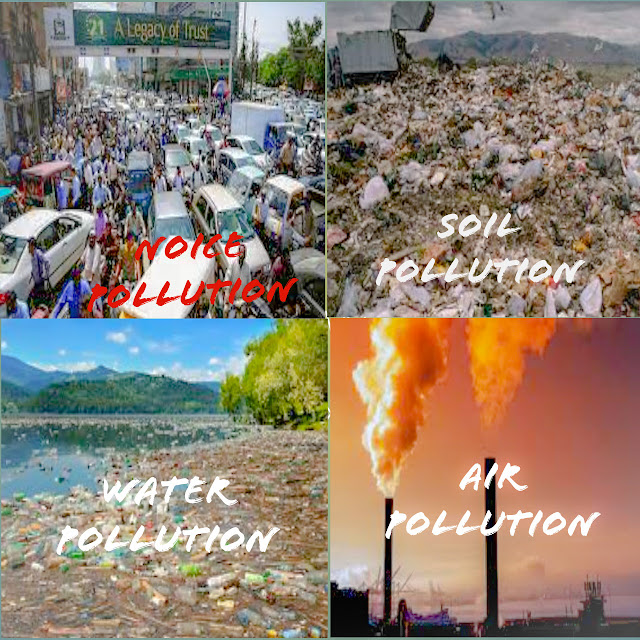POLLUTION
(1) The release of harmful and toxic substances in air, water or soil by human or natural activities is called pollution.
(2) Any change in the environment which disturbs life is called pollution.
The agent which causes pollution is called pollutant.
Types of Pollution:
Pollution is of three types.
1. Air Pollution
2. Water Pollution
3. Land pollution
Air pollution and its causes
Air pollution:
The change in composition of air by the addition of harmful substances in the form of automobile and industrial gases is called air pollution. All sources of air pollution are related to human activities
Causes of air pollution:
Major causes of air pollution are:
1. Oxides of carbon released into air from burning of fuels and automobiles.
2. Oxides of nitrogen from chemical fertilizers.
3. Oxides of sulphur released by burning of coal in brick kilns.
4. Chloro-fluoro-carbons (CFCS) from air conditioner and refrigerators.
5. Lead compounds from factories.
6. Particulants such as dust particles.
Water pollution and its causes
Water pollution:
When toxic substances are discharged into water bodies without treatment is called water pollution.
Causes of water pollution:
Major causes of water pollution are:
1. Discharge of untreated or incomplete treatment of domestic sewage to rivers and lakes.
2. Oil spills due to breakage of oil ships due to collision.
3. Industrial effluents contain toxic compounds of mercury, cadmium, lead, chromium acid arsenic.
4. Herbicides contain dioxins, a harmful chemical.
5. Insecticides such as DDT.
6. Chemical fertilizers phosphates and sulphates are added
to rivers and lakes.
Causes of land pollution:
Land (soil) is the basis for the growth of plants (producers). The main causes of land pollution are:
1. Increases in urbanization
2 Domestic daily wastes
3. Increase in agricultural land
4. Plastic factories.
5. Large animal farms
6. Chemical plants
CAUSE OF ENVIRONMENTAL PROBLEM
The major causes of environmental problems are:
1. Overpopulation
2. Urbanization
3. Deforestation
4. Acid rain
5. Greenhouse effect
6. Ozone layer depletion
Deforestation affects the environment
Deforestation:
The removal of trees on the large scale without any proper planning is called deforestation. Our life depends on forests. They are the natural factories for the production of oxygen and consumption of carbon dioxide. Earth is covered by the green cover of forest. These forests provide wild life, fuel, timber etc. Forests control the floods, soil erosion and keep the air clean.
Reasons for deforestation:
Forests are cut:
1. To construct roads, building etc.
2. For cultivation of crops
3. To develop pastures and meadows
4. For timber or fuel
5. For medicinal purpose.
6. Timber mafia cut the trees to become rich at night
Effect on environment:
Deforestation causes:
(i) Loss of habitats
(ii) Affects climatic changes
(iii) Results in deserts
(iv) Global warming
(v) Soil erosion
ACID RAIN
Acid rain:
The rain that becomes acidic with pH 3 to 6 is called acid rain.
Causes of acid rain:
It is caused by smoke and gases that evolve from factories and automobiles. They release oxides of carbon, sulphur and nitrogen. When rain falls, these oxides become dissolved and make the rain acidic.
CO2 +H2O -------> H2CO3
Carbonic acid
SO3+H2O --------> H2SO4
Sulphuric acid
NO2+H2O -------> H2NO4
Nitric acid
The pH of rain water becomes low which ranges from 3 to 6.
Effect of acid rain
Effects of acid rain:
The major effects of acid rains:
i) Damages lungS, skin and hair of humans
ii) Destroys buds and leaves of the plants
iii) Acidity of soil is increased which affects the growth of the plants.
(iv) Acid rain damages fish, aquatic plants and microorganisms in rivers and lakes.
Greenhouse effect:
The trapping of heat by a layer of gases in the earth's atmosphere is called green house effect. Carbon dioxide methane CFCs and Ozone are called greenhouse gases. The Presence of these gases in atmosphere acts like the glass in a greenhouse. They allow sunlight energy to enter but do not allow it to escape. It makes the atmosphere warmer.
The excess of greenhouse gases is also very dangerous because it will cause a rise of temperature of the earth. This effect is called global warming. The greenhouse effect is likely to cause a rise of 1.5°C to 4.5°C in average global temperate by the end of next century. Ice will melt that will cause a rise in sea level which is a threat to coastal cities. It will result increase in rainfall and flooding.
Negative effects of ozone layer depletion
Ozone layer depletion:
Ozone is an allotropic form of oxygen, having three atoms in a molecule.
A layer of ozone exists in the atmosphere about 12-50 km above the ground. This layer filters the sunlight reaching the earth. The ultraviolet light is absorbed by the ozone layer. If the ozone layer gets depleted, UV rays will reach the earth causing skin cancer and harming plant life. Ozone layer protects the life on earth from harmful effects of UV radiations.
Pollution definition, types, causes, effects,What is pollution and its effects?, What are the 7 types of pollution?,What is pollution and its types?,










0 Comments
If you have any doubts, please let me know